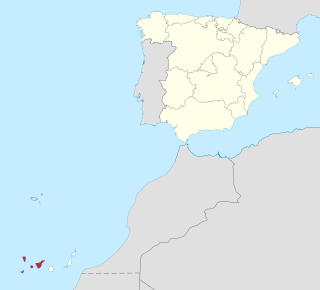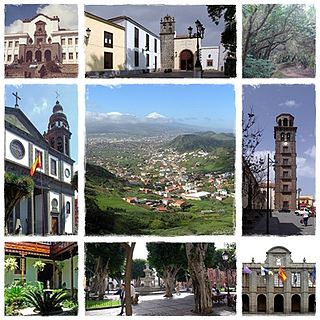Eduardo Westerdahl (Santa Cruz de Tenerife, Canary Islands, 1902 - ibidem, 1983) was a Spanish painter, art critic and writer, and a member of the Surrealist Movement.
Westerdahl was born of a Catalan mother and Swedish father. His formal education was in business management and he earned his living as a bank employee.
His private interests in philosophy and arts led him to establish the publication Iletras y Pajaritas de Papel and was editor in chief of the art revue Gaceta del arte (est 1932) which was at the lead among European art and culture magazines.
Though he greatly contributed to several important publications, the single deed that gave him most notoriety is the establishment of The Contemporary Art Museum Eduardo Westerdahl in Puerto de la Cruz (Canary Islands) which is considered to be one of the most important museums for contemporary Spanish art.

The Canary Islands, also known informally as the Canaries, are a Spanish archipelago in the Atlantic Ocean, in a region known as Macaronesia. At their closest point to the African mainland, they are 100 kilometres west of Morocco. They are the southernmost of the autonomous communities of Spain, and are located in the African Tectonic Plate. The archipelago is economically and politically European, having been colonised by Spain, and is part of the European Union.

Province of Santa Cruz de Tenerife, also Province of Santa Cruz, is a province of Spain, consisting of the western part of the autonomous community of the Canary Islands. It consists of about half of the Atlantic archipelago: the islands of Tenerife, La Gomera, El Hierro, and La Palma. It occupies an area of 3,381 km2 (1,305 sq mi). It also includes a series of adjacent roques.

Gran Canaria, also Grand Canary Island, is the third largest and second most populous island of the Canary Islands, an archipelago off the Atlantic coast of Northwest Africa which is part of Spain. As of 2019 the island had a population of 851,231 that constitutes approximately 40% of the population of the archipelago. Las Palmas de Gran Canaria, the capital of the island, is the biggest city of the Canary Islands and the ninth of Spain.

Tenerife is the largest and most populous island of the Canary Islands. It is home to 43% of the total population of the archipelago. With a land area of 2,034 square kilometres (785 sq mi) and a population of 966,354 inhabitants at the end of 2020, it is also the most populous island of Spain and of Macaronesia.

Santa Cruz de Tenerife, commonly abbreviated as Santa Cruz, is a major city, capital of the island of Tenerife, Province of Santa Cruz de Tenerife, and capital of the Canary Islands. Santa Cruz has a population of 206,593 (2013) within its administrative limits. The urban zone of Santa Cruz extends beyond the city limits with a population of 507,306 and 538,000 within urban area. It is the second largest city in the Canary Islands and the main city on the island of Tenerife, with nearly half of the island's population living in or around it.

César Manrique Cabrera was a Spanish artist, sculptor, architect and nature activist from Lanzarote.

San Cristóbal de La Laguna is a city and municipality in the northern part of the island of Tenerife in the Province of Santa Cruz de Tenerife, on the Canary Islands (Spain). The city is the third-most populous city of the archipelago and the second-most populous city of the island. La Laguna's historical center was declared a World Heritage Site by UNESCO in 1999. In 2003 the municipality started an ambitious Urban Plan to renew this area, that was carried out by the firm AUC S.L.. The city was the ancient capital of the Canary Islands. La Laguna lies right alongside the city of Santa Cruz de Tenerife; thus, the two cities and municipalities form a single large urban center, linked by tram.

Pedro García Cabrera was a Spanish writer and poet. A member of the Generation of '27, he is considered one of the greatest poets of the Canary Islands.

San Andrés is a village located on the island of Tenerife in the Canary Islands (Spain). It is located on the coast, at the foot of the Anaga mountains, 7 km (4.3 mi) northeast of the capital city Santa Cruz de Tenerife. It is administratively part of the municipality of Santa Cruz de Tenerife. San Andrés is one of the oldest villages of the Canary Islands, and was founded around 1497.

Roberto Montenegro Nervo was a painter, muralist and illustrator, who was one of the first to be involved in the Mexican muralism movement after the Mexican Revolution. His most important mural work was done at the former San Pedro and San Pablo monastery but as his work did not have the same drama as other muralists, such as Diego Rivera, he lost prominence in this endeavor. Most of his career is dedicated to illustration and publishing, portrait painting and the promotion of Mexican handcrafts and folk art.
Manolo Millares was a Spanish painter.
Domingo Pérez Minik, was a Spanish writer.
Canary Islanders, or Canarians, are a Romance people and ethnic group. They reside on the Canary Islands, an autonomous community of Spain near the coast of northwest Africa, and descend from a mixture of Spanish settlers and aboriginal Guanche peoples. Genetics shows modern Canarian people to be a mixture of mostly European, with significant North African, and minor Sub-Saharan African. The distinctive variety of the Spanish language spoken in the region is known as habla canaria or the (dialecto) canario. The Canarians, and their descendants, played a major role during the conquest, colonization, and eventual independence movements of various countries in Latin America. Their ethnic and cultural presence is most palpable in the countries of Uruguay, Venezuela, Cuba, the Dominican Republic, and the United States territory of Puerto Rico.

The Roman Catholic Diocese of San Cristóbal de La Laguna, also called Diocese of Tenerife or Diocese Nivariense, is a diocese located in the city of San Cristóbal de La Laguna in the Canary Islands in the Ecclesiastical province of Sevilla in Spain. The diocese includes the islands of Tenerife, La Palma, La Gomera and El Hierro, in the province of Santa Cruz de Tenerife. The bishop of this diocese is Bernardo Álvarez Afonso.

Fernando Estévez was a Spanish sculptor of the 18th century from La Orotava, Tenerife. He is considered one of the Canary Islands most noted sculptors.
Museo de la Naturaleza y Arqueología (MUNA), is a museum-based in Santa Cruz de Tenerife, Tenerife,. It contains many significant archaeological finds and is considered the best repository of objects from the Pre-Castilian Canary Islands. The museum also houses significant paleontological, botanical, entomological, and marine and terrestrial vertebrate collections, and is considered the best Natural Library of the Canary Islands.
The Auditorio de Tenerife "Adán Martín" is an auditorium in Santa Cruz de Tenerife, Canary Islands, Spain. Designed by architect Santiago Calatrava, it is located on the Avenue of the Constitution in the Canarian capital, and next to the Atlantic Ocean in the southern part of Port of Santa Cruz de Tenerife. Construction began in 1997 and was completed in 2003. The auditorium was inaugurated on 26 September of that year in the presence of Felipe, Prince of Asturias, and was later visited by former U.S. President Bill Clinton. The building is framed within the tenets of late-modern architecture of the late 20th century.

Eduardo Úrculo, was a Spanish pop artist who also worked in other art movements, including Expressionism and Neo-Cubism. Both painter and sculptor, he is notable for his portrayals of luggage, the gentleman's hat, and the female bottom. With El Equipo Crónica, formed by the artists Manolo Valdés and Rafael Solbes, Úrculo is considered one of the drivers of pop art in Spain.

The Cathedral of San Cristóbal de La Laguna or Catedral de Nuestra Señora de los Remedios is a Roman Catholic church in Tenerife, Spain. Begun in 1904 and completed in 1915, it is dedicated to the Virgin of Los Remedios. The cathedral is the mother church of the diocese, which includes the islands of Tenerife, La Palma, La Gomera and El Hierro in the province of Santa Cruz de Tenerife. It is therefore where the episcopal seat of the bishop of this diocese, currently occupied by Bishop Bernardo Álvarez Afonso. This is one of the most important churches of the Canary Islands.

Elizabeth Murray, born Elizabeth Heaphy, was a British watercolourist. She primarily painted portraits and landscapes of the Canary Islands, where she lived for ten years. She was a member of the Royal Institute of Painters in Water Colours, and she founded the Society of Female Artists in London.